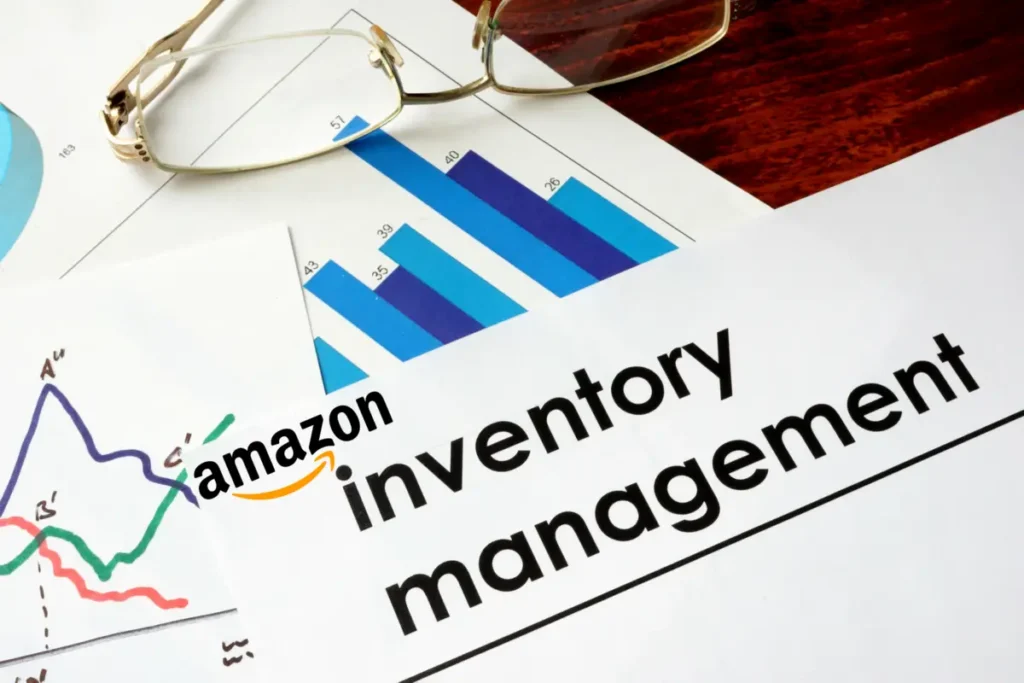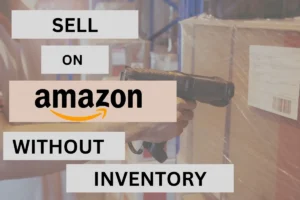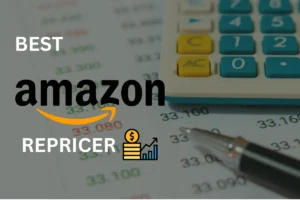Amazon inventory management is an integral part of the business as it lessens the likelihood of encountering two major profit killers: losing sales by going out of stock, and accruing costly storage fees from overstocking.
Amazon Inventory management means figuring out the processes and activities that take place between the moment you obtain your inventory and the moment you sell it to the final customer and then implementing them effectively.
Amazon inventory management is all about keeping the stock balanced, shouldn’t be too little or too much. With the right strategies(mentioned later in the post) in place, you’ll be able to figure out how to balance/maintain optimal inventory levels.
Even small tweaks to your inventory strategies can have a big impact. If done well, it can boost your sales. Missed opportunities, on the other hand, can mean lost revenue.
It applies to how you source, store, and process products to get them ready for sale. Otherwise, you won’t be able to fulfill orders on time and damage your business reputation.
Why Amazon Inventory Management Matters
Choosing the right inventory management software that aligns with your Amazon FBA business is important to maximize your efficiency.
All you need to do is to improve your management skills, set clear goals, and use optimized strategies and extensive innovative hi-tech solutions to accelerate supply chain operations, enabling the marketplace to build the Amazon supply chain of tomorrow.
A successful inventory management strategy can lead to a significant increase in sales, high-ranking seller ratings, and positive reviews and contribute to your business’s overall success.
Consider incorporating both Amazon inventory management and warehouse automation together with strategical prioritization of Amazon supply chain management.
With the right processes in place, most of your inventory management can be completely automated, either with Amazon’s online selling tools or through a professional inventory management company.
Here are some key benefits you’ll get if Amazon inventory management is done right:
Increase Profits
By avoiding stockouts and overstocking, you reduce lost sales opportunities and minimize storage fees.
Furthermore, you’ll gain valuable insights to make informed decisions on which products to stock up on, which ultimately leads to higher profit margins.
Improve Customer Satisfaction
No one likes it when their desired product is out of stock or takes ages to arrive. You won’t let your seller rating take a hit just because you didn’t keep track of your products.
An optimized and well-organized inventory can guarantee that multiple customers get their hands on your products in a timely manner, which will undoubtedly result in increasing their satisfaction and the reputation of your Amazon store.
Reduce Inventory Costs
Amazon Inventory management can help you save money from multiple angles i.e.,
- Sellers will know what items to restock and when, so they don’t spend money on products they can’t sell and overpay for storage and warehousing.
- Inventory management gives sellers the visibility they need to make smarter purchasing decisions that can help them keep up with trends and take advantage of cost-saving opportunities.
- Over-ordering the items like food, drugs, or cosmetics with expiration dates may remain unsold products for a longer period of time. and the costs of Amazon Inventory management may help you avoid the costs associated with storing, spoilage/disposing of unused items.
Explore our Amazon seller extension for free now!
Consequences of Not Having Good Amazon Management
Now that you have a better understanding of how important strategic and efficient Amazon inventory management is, now let’s take a look at the other side of the coin: What are the consequences of not having a good Amazon management system?
Running out of inventory
Not meeting the demands of the customers on time because of not having enough products in stock will ultimately impact your sales as well as the overall ranking of your listings.
Overstocking Amazon inventory
Amazon wants products to move in and out within a 90-day span — the quicker the better. If the product goes over 90 days, Amazon will consider it as excess inventory.
Keep in mind that Amazon is a fulfillment center and not a storage facility.
Stranded inventory
Stranded inventory is a common issue many sellers don’t know how to fix. This happens when inventory stored in Amazon’s warehouse is no longer connected to an active listing on Amazon. It’s basically in limbo — it’s sellable, but no customers can actually purchase it.
The considering point here regarding stranded inventory is that even if your products are not selling on Amazon, you will still be charged monthly storage fees for each unit.
Long-term Storage Fees
Your inventory age is calculated from the day it arrives at FBA warehouses.
Any inventory that has been stored in a fulfillment center for more than 271 days will be subject to the aged inventory surcharge in addition to the usual monthly storage fees.
Amazon will also continue to charge the aged inventory surcharge for units stored for longer than 365 days.
Read about all these fees and how they apply to you in our guide to Amazon fees blog post.
For units aged 271-365 days, you will be charged $1.50 per cubic foot. For units aged 365 days or more, you will be charged $6.90 per cubic foot or $0.15 per unit, whichever is greater.
Around the 18th of each month, Amazon assesses its entire fulfillment network to calculate the age of each seller’s stored inventory.
Excess inventory affects your overall IPI (inventory performance index) score.
Having too much inventory in Amazon’s fulfillment centers will reduce your inventory capacity limits leaving you with a monthly fee ( which depends on how many of your stored units are considered long-term.)
These large bills pile up — sometimes to sums greater than the value of your unsold inventory!
If you have inventory stored in FBA, Seller Central has the FBA Inventory performance tool to help you determine if you have excess inventory, as well as address stranded inventory and long-term seller fees.
Amazon Management Best Practices
The only way that can keep your inventories managed is to explore and adopt best practices and apply them consistently. You’ll need to:
- Stay on the lookout for delays in listing, selling, or delivering products.
- Respond to problems as soon as they arise to help minimize costs.
- Maintain a good sell-through rate.
- Improve inventory performance overall.
Good Amazon inventory management is about balance. You want to make sure you have enough inventory to cover demand, but not so much that you become overstocked.
Monitor Your Sell-Through Rate
Sell-through rate measures how well you’re balancing your inventory levels.
The key is to keep juggling to maintain a healthy balance between incoming and outgoing inventory.
Equip yourself with a Sales Forecasting Method or gauge past order quantities to anticipate demand. Don’t overstock, as this will only increase your warehousing costs.
Restock Popular Products Quickly
While our focus till now is to avoid excess inventory, it’s high time to discuss that keeping enough stock on hand to meet customer demand even during your busiest seasons.
Strategically plan to monitor the sales i.e., how much inventory you will need throughout the calendar year.
Keep enough backup units to ensure you won’t run out of stock due to supply chain mishaps, whether a storm that snares shipments or a mistake in fulfilling orders.
Setting Reorder Points
Set reorder points for each product to ensure that you never run out of stock.
Setting reorder points basically means monitoring and adjusting your reorder points for your inventory to meet the demand for your products. This helps ensure that you always have enough goods in stock to fulfill orders while quickly minimizing excess inventory costs.
By tracking the sales of your products and other factors such as ordering trends and manufacturing lead times, you can determine a suitable reorder point that will minimize wastage and maximize efficiency.
There are several different ways to set reorder points for your inventory at Amazon.
One standard method is to calculate an average number of days’ supply based on past sales rates and order lead time, then use this figure to set a target to reorder points.
So let’s say you sell a specific product, and you’ve noted that over the past 6 months, you’ve been selling an average of 10 units per day. Therefore, your average sales rate is 10 units/day.
Now, let’s assume it takes approximately 30 days from the time you place an order until it’s available for sale on Amazon – this is your order lead time.
Using this method, you’d want to place a new order when you have just enough inventory left to last you those 30 days.
Considering your sales rate, this would be when you have 300 units left (10 units/day x 30 days). Therefore, 300 units would be your reorder point.
Another option is to use a safety stock calculation, which considers the amount of time that it would take to receive more products if an order was placed.
Let’s consider an example:
Imagine you sell handmade candles, and it takes 14 days for your supplier to deliver a new batch once you’ve placed an order.
However, you’ve noticed that your sales can sometimes spike unpredictably – maybe due to a holiday, or a sudden influx of customers.
This variability is a risk because it might cause you to sell out before your next order arrives.
To prevent this, you decide to keep a safety stock.
You calculate that during those 14 days, the maximum number of candles you’ve ever sold is 200, while the average number is 150. This means the sales can increase by up to 50 candles during the lead time.
To cover this, you decide to always keep an extra 50 candles on hand as safety stock.
This way, even if you see a spike in sales after placing an order, you have enough extra inventory to avoid running out before your new stock arrives.
While these methods can be useful for determining your optimal reorder point, you may find that a different approach works better for your specific business needs.
Run Promotions to Reduce Aging Inventory
Avoid spoilage or unnecessary storage fees.
Zero in on products eligible for promotions to increase sales and free up storage space in your warehouse.
When products haven’t sold in over 90 days, you can take action to avoid the aging stock.
Amazon’s Inventory Performance Index can provide custom recommendations such as removing items or liquidating stock with promotions or limited-time offers.
Keep an Eye On Your Margins
Healthy sales margins are a sign of your business’s vitality.
Track all your operating costs, including the cost of procuring goods, shipping, storage, and order fulfillment.
Simple steps have the power to transform lackluster sales into a booming business. The more efficiently you manage your inventory, the more profitable your business can become.
Cornerstones of healthy inventory management include shipping products as quickly as possible, maintaining enough stock to meet demand (even during peak seasons), and insulating your supply chain against hiccups due to weather and other unpredictable factors.
In particular, focus on areas where you can cut back on costs, such as storage and order fulfillment.
Continuously manage your inventory to get a return on your investment.
Using Ecom Circles Inventory Management Software
Choosing the right inventory management system can help maintain appropriate inventory levels. There are many software options out there to choose from.
Be sure to select a system that:
- Syncs with your order fulfillment or selling website
- Provides demand forecasting
- Alerts you when items are running low
- Allows quick and easy barcode scanning
- Tracks all relevant product information
Ecom Circles’ automated dropshipping software has all these features and many more.
Whether you choose FBA or use an alternative resource for your fulfillment, Ecom Circles as an inventory management software combines innovative technology with warehousing solutions to manage your inventory.
With 2 warehouses, 30,000 sq ft of space, and 23 full-time warehouse team members, we help you:
- Receive Purchase Orders
- Keep Track Of Inventory
- Ship Orders with Competitive Shipping Rates
- Handle Returns Effectively
- Store Your Inventory
- And Include WFS or FBA prep services
Ecom Circles’ third-party logistics services are a modern solution for marketplace sellers who struggle to get their orders fulfilled in a simple and streamlined way.
Our cutting-edge technologies and user-friendly approach make it possible to execute each step of the fulfillment process without the fuss, and without doing the hard work yourself.






